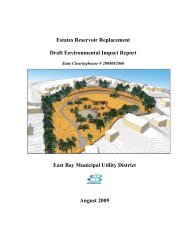Dingee Reservoir Final Seismic Report - East Bay Municipal Utility ...
Dingee Reservoir Final Seismic Report - East Bay Municipal Utility ...
Dingee Reservoir Final Seismic Report - East Bay Municipal Utility ...
- No tags were found...
You also want an ePaper? Increase the reach of your titles
YUMPU automatically turns print PDFs into web optimized ePapers that Google loves.
The next Generation Attenuation relations (NGA, 2008) developed by Abrahamson and Silva, Boore<br />
and Atkinson, Campbell and Bozorgnia, and Chiou and Youngs were used to compute estimates of<br />
median plus 1-sigma ground motions. These four relations were selected as they have characterized site<br />
conditions in terms of V<br />
S<br />
(30m) in a consistent manner. Additionally, several of the relations have<br />
included depth to 1 km/sec (or 2.5 km/sec) material as independent variables to more accurately<br />
characterize strong ground motions at sites with shallow depths to bedrock materials, as occurs at<br />
<strong>Dingee</strong> Dam. The NGA relations (NGA, 2008) provide median as well as median plus 1 standard<br />
deviation estimates of 5% damped pseudo absolute response spectra over the period range of 0.01 sec to<br />
10.00 sec. The estimates are for an average horizontal component termed GM roti which was developed<br />
to be independent of orientation of the horizontal component (NGA, 2008) and very closely reflects a<br />
geometrical average horizontal component. Figure 1 compares median plus 1 sigma estimates<br />
computed with the four selected relations for M 7.25 at a rupture distance of 0.3 km, a V<br />
S<br />
(30m) of 600<br />
m/sec, and depth to 1 km/sec material of 5m. Also shown is the weighted average (log average)<br />
spectrum (Table 1), assuming equal weights. It should be noted the range in 84 th percentile estimate<br />
(epistemic variability) is not large and may be underestimated as a result of the close cooperation<br />
between the NGA developers. This consideration typically does not impact deterministic assessments<br />
of 84 th percentile motions as it is usually neglected in the averaging process. For probabilistic hazard<br />
analyses, the lack of adequate epistemic variability for source and site location conditions poorly<br />
reflected in the strong motion database can result in motions at a higher exceedence frequency than<br />
desired. In computing the average (log) median plus 1 sigma spectrum shown in Figure 1, the epistemic<br />
variability (differences between the four estimates of the 84 th percentiles) has been included. This<br />
process results in an average 84 th percentile motion that includes both aleatory (randomness defined by<br />
the standard deviation of each ground motion relation) and epistemic variability.<br />
To develop time histories, the spectral matching criteria prescribed in ASCE 43-05 (2005) was<br />
followed. Input (basis) time histories (Table 2) were selected which displayed strong forward<br />
directivity pulses, considered appropriate for 84 th percentile motions. The spectral matching used a<br />
frequency<br />
PACIFIC ENGINEERING and ANALYSIS 2

















